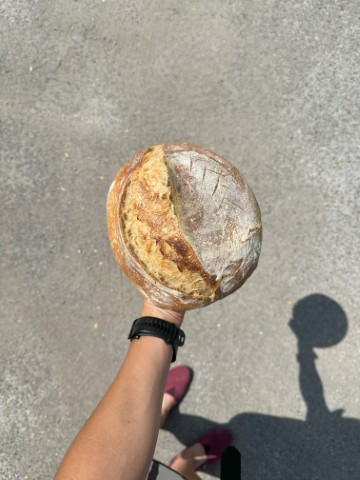

Sourdough Bread
I didn’t catch the sourdough-madness wave during the pandemic in 2020, but soon enough my curiosity needed me to give this bread a shot. In the fall of 2023, I tried a recipe online, then another recipe, and then another recipe, but it wasn’t working out. The more I researched, the more conflicting opinions I found (believe it or not I’ve found sourdough recipes that asked for active dry yeast). I also learned that there is a lot of “science” behind sourdough bread, but that following all the rules is inversely proportional to enjoying the baking process. So, I’ll attempt to give a straightforward, not-fun-draining guide to sourdough bread here.
The Sourdough Starter: Patience. If I had to describe the whole process of making a sourdough starter in one word, that’s the one I would choose. You are making a living creature. A starter that’s suitable for baking takes +7 days.


Ingredients and Equipment
- Whole wheat flour
- Bread flour
- Warm water
- Patience
- A jar or container
- Cloth or paper towel and rubber band for covering the jar
Procedure
- Add 70 grams of whole wheat flour and 70 grams of warm water to a jar. Mix it with a fork, making sure that the flour is well incorporated. Cover the jar, but not airtight. Let it rest in a warm place for 24 hours.
- Feed the starter with 70 grams of bread flour and 70 grams of warm water. Let it rest for 24 hours.
- Discard (yes, just throw away) about half of the starter. Feed it again with 70 grams of bread flour and 70 grams of warm water. Let it rest for 24 hours.
- Repeat Step 3 (discard some, feed, let rest) for another 4 days.
- If your starter is bubbly, scoop a little (around 1 teaspoon) into a glass with room-temperature water. If it floats, you can now bake with your starter.
General Tips
- Keep your starter in a warm place (75-90F).
- Don’t close the starter’s container completely. It needs air to grow.
- If you’re baking less than once a week, store your starter in the fridge and feed it once a week.
- Feeding your starter after birth only requires equal amounts of bread flour and warm water.
Bread-Time
As I mentioned, there is a lot of science and too many variables behind sourdough. This recipe will yield 1 loaf.
Equipment
- Bowl for preparing the dough
- Banneton or bowl with a cloth
- Sharp knife for scoring the dough
- Dutch oven
Ingredients
- 360 grams warm water
- 100 grams active sourdough starter
- 10 grams salt
- 425 grams bread flour (+12% protein content)
- 75 grams whole wheat flour
Procedure
- In the evening of day 1, activate your sourdough starter: feed it flour and water. Leave it in a warm spot to resuscitate overnight.
- In the morning of day 2, check if your sourdough starter is back alive by doing the float test.
- In a large bowl, mix the warm water with the active starter. Stir in the salt and both flours. Combine well. Cover it and let it rest 30-45’.
- Stretch and fold the dough, then cover and let it rest for 30-45’.
- Do the 1st, 2nd, and 3rd coil folds, resting between each fold for 60-90’. Let it rest until it doubles in size.
- Pre-shape and shape the dough as described.
- Refrigerate the dough for 12-24 hours.
- Preheat your oven to 450°F with the Dutch oven in it for 30’. Score the dough and bake covered for 30’, then uncovered for 15-20’.
- Let the bread cool down for at least 20’. Enjoy!
